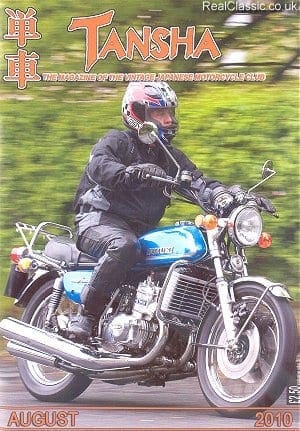
For our regular look at the vintage Japanese bike scene, Steve Cooper considers the effects of technology, and we take a sneak peek inside the VJMC’s latest publication…
Just what did we do before the advent of computers and the like? I ask because, although I and many friends are locked in a mechanical time warp with regards to our bikes, we actually depend on modern technology to keep them running.
No I don’t mean we hook up a 1967 Honda CB77 to a PC and download its latest data; we use the technology on hand to ensure we get what we need. It doesn’t matter if it’s a PDF workshop manual, a list of remanufactured spares from the other side of the world or a set of points and condensers from an eBay seller in Bolton; the advent of the home PC has opened up vistas (sic) that were unimaginable twenty years ago.
It is now possible to search, find, order and pay for a set of 1973 Yamaha RD350 reed block rubbers on Sunday evening potentially safe in the knowledge that you can be bolting them in on Friday evening ready for a ride the following day. The fact that the part are made in the Far East for a USA based company specialising in such products simply doesn’t even enter our conscious thought most of the time.
Another fascinating electronic device has to be the digital camera. As many have discovered it’s as useful in the workshop as any toolkit and is generally infallible, unlike most of our memories. Where did that green wire with the blue tracer go? Which side of the swinging arm does the brake cable sit? Which way round do those damn seat hinges face? If you took a few shots of the bike before you flailed your way in with the spanners you could have downloaded them and worked in much less frenetic manner.
|
|
Classic Suzukis on Now… |
All this modern technology is taken for granted and we use it every day but not so long ago you’d have sworn the whole lot was the work of the devil. The same used to be said of Japanese motorcycle (and cars for that matter) but now they are a daily part of our lives. Proven technology is a marvellous thing and anyone who dismisses it without making effort to understand it is either a bigot or daft.
Yesterday’s technical leap is tomorrow’s collectible curio and my garage is full of ’em.
—————–
The VJMC produce a monthly full colour A5 magazine, called Tansha, which runs to some 60 pages and is supplemented by a mono, 30-page directory. This clever arrangement means that precious glossy pages aren’t wasted with the all the necessary-but-uninspiring info like details of club officials, where local sections meet, and the small ads. It also means that VJMC members effectively get an extremely comprehensive monthly magazine which is as big as many commercial publications.
The August 2010 issue included full colour features about selecting stainless spares for a Z650, restoring a Honda S90, going salt-lake racing, Suzuki’s Isle of Man racing history, visiting breakers’ yards in the USA, riding a KH400 triple in Devon, going by 1500 Goldwing to the Scottish highlands, plus reports on the Club’s many events including the Suffolk, Bangor, Cardiff, Nabs Head and Stanford Hall Classic Bike Clubs’ Shows. Award winners might find their photos in this section!
|
|
Classic Yamahas on Now… |
Then the ‘Directory and Autojumble’ goes into glorious, grubby detail with masses of useful, hands-on information. The VJMC holds marque registers for Mini-Bikes, Read-Titans, XS650 twins and Bridgestone machines, plus there are specialists available for many makes and specific models. These keen volunteers provide experienced and relevant advice to Club members, and the bikes covered include Honda’s CBX1000, CB400/4, CB750/4 and CB1100R; Kawasaki two-strokes, Z1300s, roadgoing four-strokes, and race machines; Suzuki Kettles; Yamaha air-cooled RDs, XTs and FS1-Es. There’s even a chap to ask if you have a specific MoT enquiry!
The mono booklet contains half a dozen pages of useful trade contacts of people offering member services – ranging from motorcycle training to ignition keys, from parts cleaning to rust removal, full restoration to solar battery chargers. The really rare parts turn up in the members’ autojumble section, packed with plenty of spares for sale and some jolly interesting Japanese classics for reasonable cash. 400/4 for £1000, anyone? Katana 750 with pop-up headlight for £1200? A Suzi GT500 stroker for £1600?
This range and variety of information and entertainment is provided each month by the VJMC to its members. Joining the VJMC currently costs £5 on top of the £25 per year standard membership rate. All the info is here: www.vjmc.com/membership.htm with an option to pay online.





